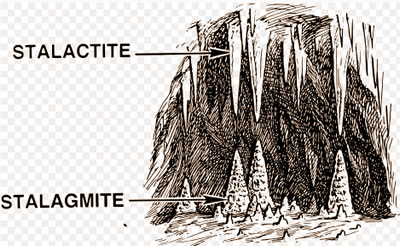As rainwater falls, it dissolves carbon dioxide from the air forming carbonic acid. This weak acid corrodes calcite (calcium carbonate), the main mineral component of limestone rocks.
The acid dissolves the limestone and sculpts the rock, especially along joints and lines of weakness in the strata. Flowing rainwater makes its way through the dissolved gaps and holes and erodes caverns underground along the level of the water table.
Where the water table reaches the surface, as on a slope, a spring forms and drainage is established. The place where the spring emerges is called the resurgence.
At the level of the water table the pattern of linked caves is similar to that of a river, with converging branches and meanders formed by the flow of the water.
Below the water table caves are formed by solution effects, with no current-formed features. These caves are full of water, joined to blind tunnels and hollows if the solution evaporates, if its concentration of carbon dioxide is reduced, or if it is agitated.
In caves evaporation is minimal because the atmosphere is saturated, but the other two factors are important. When the solution seeps through to the ceiling of a cave it may hang there as a drip. Mainly through the loss of carbon dioxide, the dissolved calcite is deposited on the ceiling, as a minute mineral particle. This process happens also to the next and subsequent drips and over the years the accumulated particles produce a hanging icicle-like structure. It may take a thousand years to deposit a centimeter of stalactite. The shapes of stalactites vary. Some are long and thin; others form curtain-like structures where the seeping water trickles down a sloping ceiling. A constant wind blowing through the cave may cause the stalactite to be crooked or eccentric.
Water from the stalactites drips to the floor. There the shock of the impact causes the calcite to separate from the water, which either flows away or evaporates. Constantly repeated, the result is the upward-growing equivalent of a stalactite - a stalagmite.
 Stalagmites also vary in shape; some resemble stacks of plates, whereas others have ledges and flutes that make them look like gigantic pine cones.
Stalagmites also vary in shape; some resemble stacks of plates, whereas others have ledges and flutes that make them look like gigantic pine cones.
Occasionally a stalactite and a stalagmite meet and grow into each other, producing a column. At times the calcite-rich water seeps through the wall into the cave, usually along a bedding plane, and gives rise to a cascade-like structure called a balcony, with stalactites and stalagmites that seem to flow over each other.
In the bed of an underground stream the calcite-rich water inevitably passes over ridges in the bed. A slight turbulence results and a particle of calcium carbonate is deposited on the ridge. This action is self-sustaining, because the more calcium carbonate there is deposited on an obstruction, the larger the obstruction becomes and the greater the turbulence. The result is a series of stalagmite ridges with horizontal crests, which act like dams that hold back the water in pools. These little dams are called gours, or rimstone pools.
The calcite that forms these features is a colorless mineral but impurities (mostly iron and manganese salts) stain the stalactites and stalagmites delicate shades of pink and yellow. The staining varies according to the composition of the rocks that the seeping water has passed through and it produces concentric patterns in the icicle-like stalactites, and bands of color on the curtain type.
People and Caves
Caves were the traditional homes of some early tribes of Mankind; their artifacts have been found buried in floor debris, and their paintings have been found on walls. The most important of such sites are in the Spanish Pyrenees and the Dordogne valley in France, which have caves that were inhabited about 25,000 or 30,000 years ago.